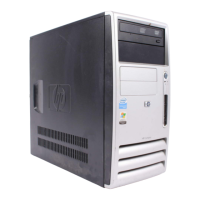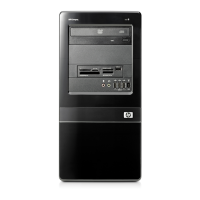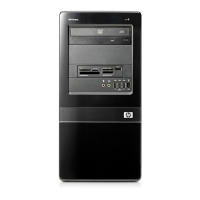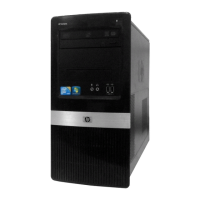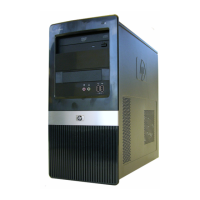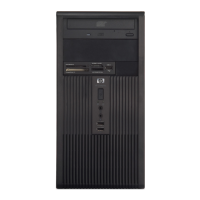Technical Reference Guide www.hp.com 4-23
System Support
4.5.3 System Status
These systems provide a visual indication of system boot, ROM flash, and operational status
through the power LED and internal speaker, as described in Table 13.
d
.
NOTES:
Beeps are repeated for 5 cycles, after which only blinking LED indication continues.
[1] Repeated after 2 second pause.
[2] Beeps are produced by the internal chassis speaker.
[3] Check that CPU power connector P3 is plugged in.
4.5.4 Thermal Sensing and Cooling
All systems feature a variable-speed fan mounted as part of the processor heatsink assembly. All
systems also provide or support an auxiliary chassis fan. All fans are controlled through
temperature sensing logic on the system board and/or in the power supply. There are some
electrical differences between form factors and between some models, although the overall
functionally is the same. Typical cooling conditions include the following:
1. Normal—Low fan speed.
2. Hot processor—ASIC directs Speed Control logic to increase speed of fan(s).
3. Hot power supply—Power supply increases speed of fan(s).
4. Sleep state—Fan(s) turned off. Hot processor or power supply will result in starting fan(s).
The RPM (speed) of all fans is the result of the temperature of the CPU as sensed by speed
control circuitry. The fans are controlled to run at the slowest (quietest) speed that will maintain
proper cooling.
✎
Units using chassis and CPU fans must have both fans connected to their corresponding headers
to ensure proper cooling of the system.
Table 4-13.
System Operational Status LED Indications
System Status PowerLED Beeps [2] Action Required
S0: System on (normal operation) Steady green None None
S1: Suspend Blinks green @ .5 Hz None None
S3: Suspend to RAM Blinks green @ .5 Hz None None
S4: Suspend to disk Off – clear None None
S5: Soft off Off – clear None None
Processor thermal shutdown Blinks red 2 times @ I Hz [1] 2 Check air flow, fans, heatsink
Processor not seated / installed Blinks red 3 times @ I Hz [1] 3 Check processor presence/seating
Power supply overload failure Blinks red 4 times @ I Hz [1] 4 Check system board problem [3],
Memory error (pre-video) Blinks red 5 times @ I Hz [1] 5 Check DIMMs, system board
Video error Blinks red 6 times @ I Hz [1] 6 Check graphics card or system board
PCA failure detected by BIOS (pre-video) Blinks red 7 times @ I Hz [1] 7 Replace system board
Invalid ROM checksum error Blinks red 8 times @ I Hz [1] 8 Reflash BIOS ROM
Boot failure (after power on) Blinks red 9 times @ I Hz [1] 9 Check power supply, processor, sys. bd
Bad option card Blinks red 10 times @ I Hz [1] None Replace option card
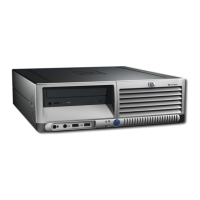
